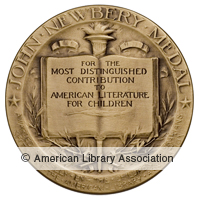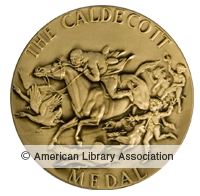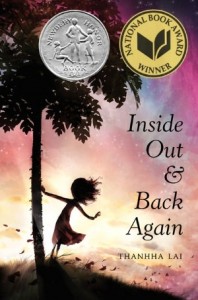

I’m usually interested in the annual choices, but this year, because of this blog, I was one of the breathless audience in cyberville, pencil in hand, ready to scribble down honor books and medal winners. As it turns out, we’ve already reviewed the Gold Medalist for the Prinz Award (created in 1999 for excellence in young-adult fiction), and a Caldecott honor book (Grandpa Green). Starting today and for the next couple of weeks, I’ll look at the other Newbery and Caldecott books, as well as selected books from the fourteen other youth media categories. (One item of interest: the Mildred Batchelder Award, given for best translation, went to Eerdman’s Press in Grand Rapids—the only Christian publisher in the bunch.)
As most library parents know, the Newbery Award has been around for a long time—90 years. The 1922 winners included books for children of any age, so picture books as well as novels were awarded Newbery medals until 1937, when the Caldecott award was created. In the last 15 years or so there’s been an explosion of new award categories, based on whatever ethnic or social group has been left out all this time. But the Newbery is still the premier award. There’s always one gold-medal book, but the number of silver medals (honor books) to grant, or if any, is entirely up to the committee of that year. In 2011, there were four honor books. This year—audible gasp from the audience in Dallas–only two. Sometimes the winners have received a lot of advance buzz, and sometimes they come out of the blue. This year was a mix: one first-time, first-novel winner; one old hand; and one author who is better known for picture books. So beginning today, my reviews of the 2012 Newbery and Caldecott winners:
Inside Out and Back Again, by Thanhha Lai. HarperCollins, 2011, 262 pages. Age/interest level: 12 and up.
Vietnamese New Year is called Tet, which falls on February 11. Everyone is considered a year older on Tet, regardless of their actual birthday. Ha Ma (whose nickname means River Horse, or Hippopotamus), is ten at the dawning of the New Year, 1975, and while still in bed beside her mother, she performs a little act of rebellion. It’s traditional that the oldest boy in the house must be the first person up on the morning of Tet, so the family will have good luck. But why should that be? thinks Ha. She slips her own foot out from under the covers and sets it on the floor, an act which she will have reason to regret. Because that might have led to the extraordinary luck that befalls her family in 1975.
Most of the Americans have left VietNam, but the atmosphere is edgy for Ha’s family. They are particular targets for the encroaching VietCong because her father was a Vietnamese naval officer who fled to the south in the early years of Ho Chi Min’s revolution. During the war that followed he was listed as missing in action, even though the family hopes that he’s still alive. This makes Ha’s mother’s decision to flee the country much more difficult than it might have been otherwise, but it appears she has no choice, with Saigon doomed to fall. Soon Ha, her mother, and her three older brothers are packed aboard a smuggling ship which cruises the river route to the open sea without lights, cooking, or bathroom breaks. Once at sea, they learn that Saigon has fallen to the Communists and there’s no going back; they have joined the ranks of Vietnamese “boat people.”
Upon their arrival on the U.S. island territory of Guam, where the terrible food is redeemed by nuoc mam (fish sauce), Mother makes another momentous decision: to go to America. At that time it was easy, probably due to American guilt at getting involved in Vietnam in the first place (or for not finishing the job, once involved). In a Florida refugee camp, Mother adds the word “Christian” to their sponsor application because she’s heard it improves one’s chances of getting a sponsor.
Apparently so; their new sponsor is a bluff, hearty Baptist with a cowboy hat. “I love him/immediately/and imagine him/to be good-hearted and loud/and the owner of a horse.” No horse, unfortunately, and the family’s reception in Alabama is cool until they all present themselves for baptism at church. It’s purely pragmatic, but it warms up the Baptists. It’s only the beginning, though; Ha and her family still have very difficult adjustments to make, at school, at work, and in the neighborhood. One girl at Ha’s school has only seen Vietnamese on TV, so she pulls the new kid’s hair to make sure she’s real. Even good intentions can have unhappy consequences, such as when Ha receives a blue nightgown in a Christmas package and wears it to school because she thinks it’s a fancy dress. While trying to live in America, she finds herself still in limbo: “I wish/Father would appear/in my class/speaking beautiful English/as he does French and Chinese/and hold out his hand for mine./ Mostly/I wish/I were/still/smart.”
Inside Out and Back Again is based on the author’s own experiences, and she describes the home she left with heart-rending clarity. As I’ve indicated with the quotes, the narrative is written in free verse, which may cause some kids to drop the book like a spider. They shouldn’t; once into the story, they’ll hardly notice the form. In an afterward, Thanhha Lai explains that she wrote for her nieces and nephews, who know where their parents came from but “they can’t really imagine the noises and smells of Vietnam, the daily challenges of starting over in a strange land. I extend this idea to all: how much do we know about those around us?”
That’s the greater point: not just refugee experiences, but the essential strangeness of other people from other backgrounds and families very unlike our own. (It works in reverse, too—it’s hard to believe southern Baptists are quite as dumb as Ha Ma sees them.) Readers may not like all of Ha Ma’s impressions, but they may at least understand how she came by them. One caution: young readers will need a little historical background, which the author doesn’t provide, to understand the situation as the story opens. This is fairly easy to come by. Also, some of the situations she describes, especially on board the smuggling ship, are rather earthy and there’s some slightly coarse language. Otherwise, it’s worth reading, and while Americans are not presented as saviors, the Communists are clearly the bad guys.
For more books on a similar theme, see “Living Like a Refugee.” And don’t miss our new series on understanding other cultures through literature, beginning with Japan. For reviews of the Newbery winners from last year, start here.
Stay Up to Date!
Get the information you need to make wise choices about books for your children and teens.
Our weekly newsletter includes our latest reviews, related links from around the web, a featured book list, book trivia, and more. We never sell your information. You may unsubscribe at any time.
Support our writers and help keep Redeemed Reader ad-free by joining the Redeemed Reader Fellowship.
Stay Up to Date!
Get the information you need to make wise choices about books for your children and teens.
Our weekly newsletter includes our latest reviews, related links from around the web, a featured book list, book trivia, and more. We never sell your information. You may unsubscribe at any time.
FREE Bible Guide!
Get a guide to the Best Bibles for Children and Teens. Perfect for an Easter gift.
We'd love to hear from you!
Our comments are now limited to our members (both Silver and Golden Key). Members, you just need to log in with your normal log-in credentials!
Not a member yet? You can join the Silver Key ($2.99/month) for a free 2-week trial. Cancel at any time. Find out more about membership here.
2 Comments
Leave a Comment
You must be logged in to post a comment.




I really loved Inside Out when I first read it and even said in my blog review that I fully expected to update my post *when* it won awards… and it’s won twice now!! (well, if you count an honor in that)
I think it’s a beautifully written book, and I think it’s so helpful for kids to see both how other cultures live/think as well as how Christians are often perceived. Much food for thought in a lovely package, that one.
Thanks for keeping up with this, Janie!